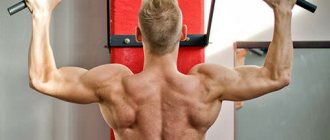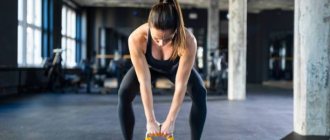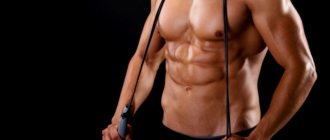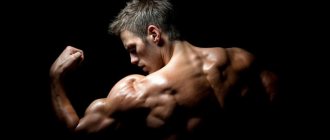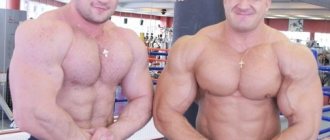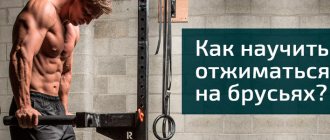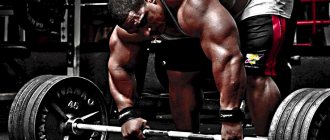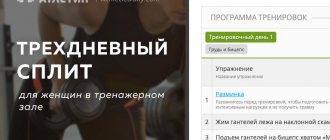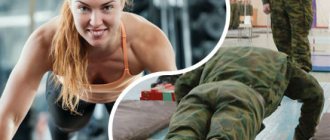Content
- 1 What muscles work during dips?
- 2 Push-up technique for girls
- 3 Number of repetitions and approaches
- 4 Additional materials
Video: Push-ups for girls
Push-ups for girls: technique Push-ups for girls: muscles
Almost everyone has seen how push-ups are performed. This element, for example, is included in standard army gymnastics. However, you should not try to blindly repeat what you saw on the TV screen, because you may not take into account many of the subtleties of performing this exercise that is useful for your figure.
These exercises are recommended for intermediate or advanced levels. And in order to do push-ups correctly, you need to know which muscle groups are trained, what the starting position is, and how to move correctly.
Summer is approaching, the street is getting warmer, clothes are becoming lighter and shorter. Girls are starting to wear skirts, and young people will soon begin to wear T-shirts and T-shirts... If girls often don’t have to do anything to slim women’s legs, then young people have to make a lot of effort to acquire a beautiful torso... As soon as it began to get warmer outside, an unknown force pulled the young people to the horizontal bars and uneven bars. Agree, it’s much nicer to see young guys playing sports than guys sitting in a sports town with beer and cigarettes. The problem is that many, after twitching on the horizontal bar, see that all this is useless, without even really working out. “And, anyway,” they think, “I’m doing it wrong, so there’s definitely no point…” and they join the group of drinkers and smokers. Because we, like all living things, are drawn to the light, but we need to do something so that it doesn’t get boring... In this article I will teach you how to pump up on the horizontal bar and uneven bars, and most importantly, how to do it correctly step by step. This will help beginners to properly distribute their strength, and those who work out at home or in the gym will change the atmosphere of stuffy rooms to activities that allow them to breathe fresh air and observe wonderful landscapes...
Basic moments
This program is well suited for beginners and young athletes. I'll explain why:
- When we hang on the horizontal bar, the spine stretches, which has a positive effect on growth, in contrast to training with heavy weights, where growth slows down and sometimes even stops.
- Exercises with your own weight allow you to better dose the load and avoid injuries that incapacitate beginners who start training straight away with a barbell and dumbbells, bypassing exercises with their own weight.
- This complex pumps up the muscles around the spine, which allows you to correct scoliosis at an early stage of development and minimize its occurrence in the future. Strengthened muscles hold the spine, preventing it from bending.
Why do we divide each exercise into several approaches, rather than performing it once to the maximum.
The fact is that in several approaches we will do a greater number of times, while spending less effort. If, for example, you do 15 pull-ups at one time, applying maximum effort. then in three approaches you can do 30 pull-ups, performing the same exercise 10 times in each approach, while spending less energy than in the first option. Why you need to study every other day or two, and not every day. The fact is that on rest days, muscles grow and recover. If you exercise every day, your muscles will simply have no time to grow and rest. Sometimes you will feel full of energy and desire to train every day. Don’t give in to this mood, this youthful euphoria will drive you into such a hole, from which I, at one time, got out only a few months later, having exerted considerable moral strength. It is much more effective to work out every other day, but even here you need to take into account that you should finish each workout knowing that you could still work.
Set of exercises
Here are the exercises we will work with:
1 WEEK:
We perform one series.
a) Pull-ups. b) Push-ups. c) Raising the legs to an angle of 90 degrees on the uneven bars. d) Pushing your legs back while hanging on the bar.
The most common problem for beginners is that they jump straight into the fight, doing exercises until their arms fall off. This causes their muscles to ache and the desire to exercise strangely disappears. This is why the first week is dangerous. Here you need to make a lot of effort to restrain yourself. Be patient for 1 week, since you haven’t worked out for so long before. Perform each exercise until the first signs of fatigue, finishing the exercise with the firm confidence that you would do it several more times.
How to do the exercises:
- Pull-ups .
Performed without jerking. Even if you only do 1 power pull-up, it will be much more beneficial than doing multiple pull-ups with jerks, because jerking won't build anything up. - Dips.
Try to go lower at the bottom to get more benefit from this exercise. At the top point, straighten your arms to the end. - Raising legs to an angle of 90 degrees on uneven bars
. The main thing in this exercise is not to sway. To do this, when lowering your legs, try not to move them back. If your strength allows, spread your legs at the top point, then bring your legs together and only then lower them. - Pushing your legs back while hanging on the bar.
In this exercise, try not to swing. To make the exercise more effective, perform it slowly. We move our legs back one time, two hangs (we don’t swing). If there is a wall bars or ladder, do the exercise on it, it will be much easier.
WEEK 2:
We complete 2 series. In the first series we perform the same number of times as in the first week. In the second series, we perform the same number of repetitions as in the first series. If you have the strength and desire in the second series, you can do it several times more, but so that, after finishing the exercise, you can do it one or 2 more times.
a) Pull-ups. b) Push-ups. c) Raising the legs to an angle of 90 degrees on the uneven bars. d) Pushing your legs back while hanging on the bar.
WEEK 3:
We carry out 3 series. It is advisable to do the same number of times in each series. Only in the third series can you afford to do a few more repetitions.
a) Pull-ups. b) Push-ups. c) Raising the legs to an angle of 90 degrees on the uneven bars. d) Pushing your legs back while hanging on the bar.
WEEK 4:
We carry out 3 series. In the fourth week we consolidate the results obtained.
a) Pull-ups. b) Push-ups. c) Raising the legs to an angle of 90 degrees on the uneven bars. d) Pushing your legs back while hanging on the bar.
This completes the first stage. Strength has increased a little, the flexor and extensor muscles have acquired a slight tone, the back and abs have become stronger, and the hands have become stronger. This will allow us to move on to the next stage of the complex.
WEEK 5:
We perform 3-4 series.
a) Pull-ups. b) Push-ups. c) Raising the legs to an angle of 90 degrees on the uneven bars. d) Leg abductions while hanging on the bar. d) Reverse grip pull-ups. e) Regular push-ups.
How to do the exercises:
- Reverse grip pull-ups
. In this exercise we connect the hands. Your arms cannot be fully extended. - Ordinary push-ups.
The amplitude of the exercise should be maximum. When you bend your arms, your chest should touch the ground slightly. When extending, straighten your arms completely.
WEEK 6:
We perform 3-4 series.
a) Pull-ups. b) Push-ups. c) Raising the legs to an angle of 90 degrees on the uneven bars. d) Leg abductions while hanging on the bar. d) Reverse grip pull-ups. e) Regular push-ups. g) Pull-ups with a reverse head grip. h) Reverse push-ups from the bench.
How to do the exercises:
- Reverse head grip pull-ups.
We grab the horizontal bar with a wide grip. At the top point, we “touch” the bar not with the chin, but with the back of the head. You can take a break. - Reverse push-ups from a bench
. We turn our backs to the bench and rest our hands on it. We bend and straighten our arms at the elbow joint. Our butt practically touches the ground.
WEEK 7:
We perform 2-3 series.
a) Pull-ups. b) Push-ups. c) Raising the legs to an angle of 90 degrees on the uneven bars. d) Leg abductions while hanging on the bar. d) Reverse grip pull-ups. e) Regular push-ups. g) Pull-ups with a reverse head grip. h) Reverse push-ups from the bench. i) Raising the legs to the crossbar. j) Standing backbends.
How to do the exercises:
- Raising your legs to the bar.
We try to perform this exercise without swinging with our legs as straight as possible. If it is difficult for you to lift your legs to the bar, raise them to a 90-degree angle and, if possible, pause. - Standing backbends.
The exercise is performed from a standing position. There should be a pipe or wall behind us, on which we will lean or push slightly when bending. Before starting the exercise, bend over once tentatively to determine a comfortable distance from our support and the angle at which we will bend. During the exercise, try to distribute the load evenly across the spine.
WEEK 8:
If you have reached the eighth week, then calluses should cause considerable discomfort, so the complex must then be divided into two parts. First we do the first part, then we rest for 1 day, then we do the second part. And so on according to the same pattern. We work in 3-4 approaches.
Part 1:
a) Pull-ups. b) Push-ups. c) Reverse grip pull-ups. d) Regular push-ups. e) Pull-ups with a reverse head grip. e) Reverse push-ups from the bench.
Part 2:
a) Raising the legs to an angle of 90 degrees on the uneven bars. b) Leg abductions while hanging on the bar. c) Raising the legs to the crossbar. d) Standing backbends. e) Hanging side bends. f) Hanging body rotations.
How to do the exercises:
- Hanging side bends.
We accept hanging on the horizontal bar. We move our legs straight to the left, then to the right. We try to perform the exercise as slowly as possible. - Body rotations.
We accept hanging on the horizontal bar. We turn the body to the left, then to the right. When turning to the left, you can raise your right leg, bending it at the knee; when turning to the right, bend your left leg. Try to make each turn as far as possible.
I have faith that most of you will not give up and make it to week 8.
I am always ready to help you further improve and answer any questions! Good luck!
Author: Andrey Bystrov. Photo: Natalya Mazur.
What muscles work during dips?
The action that is most noticeable with this exercise is the rotator cuff. However, other muscles also work: rhomboids, serratus anterior and pectoralis minor, and the lower trapezius muscle. The abdomen and back are tense, that is, their muscles: the pectoralis major muscle, the pectoralis minor muscle, the coracobrachialis muscle, the latissimus dorsi muscle, the large round muscle. Naturally, the muscles of the arms also work, since they support the whole body while hanging. These are the triceps and elbow muscles.
Rules for conducting classes
Bars, like any sports equipment, require strict adherence to certain established rules for performing exercises on them. These rules are quite simple, but important.
Movements made while on the uneven bars must be smooth. If you are doing push-ups, you need to go down smoothly, and if you are pumping your abs, carefully lower your legs; you should lift them in the same way.
There will be absolutely no benefit to you from jerking, but only the risk of getting a sprain or some other damage. If you exercise by doing push-ups, use parallel or angular exercises for this purpose.
The latter are more versatile, since they can be used to control the width of your grip. To train your pectoral muscles, do not spread your elbows too wide; an angle of forty-five degrees is sufficient for a comfortable and optimal load for your body.
When lowering your body, do not sit very deeply; the stretch should be comfortable. Some athletes tend to extend their arms more, which is fraught with further possible joint inflammation. Just be careful to straighten your arms, otherwise, if you overbend, there is a risk of damaging your biceps.
Push-up technique for girls
You need to choose bars so that the distance between them is wider than your shoulders and hips. This is more of a safety requirement than exercise. You need to lean your hands on these bars. If necessary, take them out by force. Your arms should be fully straightened, your chest should be straightened, and your torso should be slightly tilted forward.
Now try to bend your arms so that you feel the tension in them and in the pectoral muscles. Movements are controlled precisely by this muscle group. Return to the starting position by straightening your arms and lifting your weight on them. Then repeat.
At the same time, you cannot raise your shoulder blades and shoulders, or bring your shoulders together. The chest should be straightened. When lifting on the uneven bars, exhale.
If you are so tired that you can fall off the bars, then try to make a jump, landing strictly between them, so as not to damage the collarbone or pull the muscles. Sometimes it makes sense to perfect the dismount from the apparatus before starting to master the exercise, so as not to think about how to do it.
Rules and recommendations for training on horizontal bars and uneven bars for girls
Shoulder exercises on the horizontal bar and parallel bars are performed in compliance with a number of rules. Regular exercise helps develop the muscles of the back and chest . Exercises help maintain muscle tone. You can choose the program yourself without the participation of a trainer.
Basic Rules:
- doing exercises daily - you cannot skip classes;
- compliance with the dosage of physical activity - you need to try not to overload the body;
- selection of the optimal load - after exercise there should be slight fatigue;
- selection of an individual exercise rate - you need to create a program based on the characteristics of your body.
If a girl has recently started training, then it is better for her to train in a group of beginners. All participants must have the same level of training. The program is compiled based on the chosen goal. Exercises to strengthen muscles or lose weight are usually different.
Advantages and disadvantages of classes
Shoulder exercises on the horizontal bar and parallel bars, as a separate complex, have a number of disadvantages and advantages. The class does not require the purchase of additional equipment. The advantage of the technique is considered to be the almost complete absence of financial costs.
On the horizontal bar you can perform a variety of exercises, simple and at the same time effective. The program is selected independently. The main goal is the harmonious development of all the muscles of the body.
The advantage of the technique is also considered to be its safety - the risk of injury is minimal. If a girl plans to exercise in the yard, then in the autumn-winter period the training will have to be stopped.
This is due to bad weather. Another disadvantage can be considered the destruction of motivation caused by possible difficulties. If the exercises don't work out the first time, many people quit training.
Types of grips
Shoulder exercises on the horizontal bar and parallel bars include several types of grip:
| Grip type | Description |
| Lock | They clasp the crossbar with their hands and clasp their hands together. |
| Wide | During training, the load is evenly distributed on the back, shoulders and chest. Your arms should be slightly wider than shoulder-width apart. |
| Synchronous | When performing exercises, the trapezius, rear delta, rhomboid muscle, and shoulder girdle work. The hands must be positioned shoulder width apart. |
| Narrow | The grip can be opposite, reverse or straight. During the training, the teres minor and major, subscapularis and brachialis muscles are worked out. The brushes are placed at a distance of 12-17 cm from each other. |
| Various | Hands are placed with a reverse and direct grip. During the exercises, the position is changed to ensure an even load on the shoulders. |
| Back | The horizontal bar is clasped so that the fingers are directed towards the girl’s face. During the exercises, you must ensure that the shoulder girdle is not overloaded. |
| Straight | Hands are positioned away from the face. During classes, the back muscles are worked. |
If a girl trains on the uneven bars, then she should place her hands with a direct grip. Otherwise, it will be impossible to complete the exercises.
